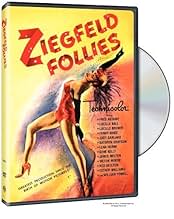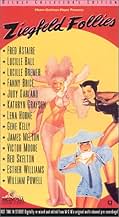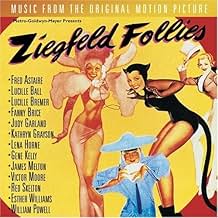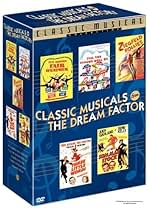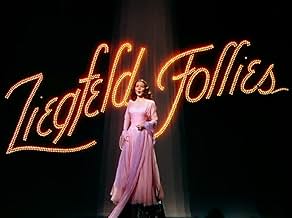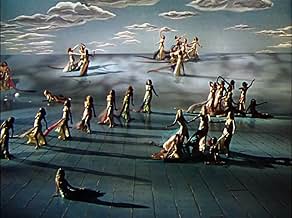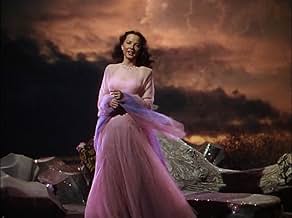ÉVALUATION IMDb
6,4/10
3,7 k
MA NOTE
Le regretté grand imprésario Florenz Ziegfeld Jr. regarde du ciel et décrète une nouvelle revue dans son grand style ancien.Le regretté grand imprésario Florenz Ziegfeld Jr. regarde du ciel et décrète une nouvelle revue dans son grand style ancien.Le regretté grand imprésario Florenz Ziegfeld Jr. regarde du ciel et décrète une nouvelle revue dans son grand style ancien.
- Prix
- 1 victoire et 1 nomination au total
Histoire
Le saviez-vous
- AnecdotesThe machine producing the bubbles for the finale was responsible for one of the greatest filming fiascoes in movie history. On the first day of filming the finale, the gas produced by the bubbles caused Vincente Minnelli's cameraman to faint on top of a forty foot lift. While Minnelli struggled to stop his cameraman from falling, the bubbles continued to pour from the machine to such an extent that the soundstage was flooded with bubbles, and no one could get close enough to turn the machine off. Eventually, the fire brigade was called to turn stop it. Afterwards, teams of workers used large rackets to keep them under control, but the gas from the bubbles remained a constant hazard, and between each take Minnelli would order the soundstage's doors open so the cast and crew could breathe. James Melton filmed with a wet handkerchief in his mouth to protect his voice. Fred Astaire and Lucille Bremer's dance was removed completely, since in every take of them, the bubbles obscured part of their face.
- GaffesTowards the end of the "This Heart of Mine" number, as Fred Astaire and Lucille Bremer begin to dance back to the palace, dancers in the background (screen left) clearly are struggling to stabilize some of the antler-tree props.
- Citations
Florenz Ziegfeld Jr.: Children play with the dreams of tomorrow. And old men play with the memories of yesterday.
- Générique farfeluZiegfeld Follies credits are in alphabetical order. That is why "Bunin" comes before "Charisse"
- Autres versionsThere is an Italian edition of this film on DVD, "FOLLIE DI ZIEGFELD", re-edited in double version (1.33:1 and 1.78:1) with the contribution of film historian Riccardo Cusin This version is also available for streaming on some platforms.
- ConnexionsEdited into Hollywood: The Dream Factory (1972)
- Bandes originalesHere's to the Girls
Music by Roger Edens
Lyrics by Arthur Freed
Sung by Fred Astaire, chorus
Danced by Cyd Charisse, Lucille Ball, chorus
Commentaire en vedette
The premise of this film is that Ziegfeld (with William Powell reprising his role) is in heaven thinking of his dream revue, with the rest of the movie just a playing out of that dream revue. I rather wonder about the direction, because this film managed to do what I've never seen done before - make William Powell appear hammy and amateurish in the opening moments as he plays Ziegfeld once again and then disappears for the rest of the film. Believe me, I say this as a huge fan of William Powell.
Thus there is no plot. It involves the big musical and comedy stars of MGM putting on a show of their various capabilities, and for all intents and purposes could be renamed "The Hollywood Revue of 1946" for those familiar with the original from 1929 which basically had the same purpose. Of course, technology has advanced considerably over the ensuing 17 years, but there are still some missteps. Basically, the musical numbers are good, but the comedy skits that punctuate them fall very flat and detract from the entire film. The highlight for me was seeing Fred Astaire and Gene Kelly perform together in a number. The musical numbers make this an above average film, but just barely.
It is most valuable because it shows MGM just as it begins to lose its grip as a leader in the film industry in the post-war era, and also because it reinforces what Buster Keaton always said - that MGM never "got" comedy.
Thus there is no plot. It involves the big musical and comedy stars of MGM putting on a show of their various capabilities, and for all intents and purposes could be renamed "The Hollywood Revue of 1946" for those familiar with the original from 1929 which basically had the same purpose. Of course, technology has advanced considerably over the ensuing 17 years, but there are still some missteps. Basically, the musical numbers are good, but the comedy skits that punctuate them fall very flat and detract from the entire film. The highlight for me was seeing Fred Astaire and Gene Kelly perform together in a number. The musical numbers make this an above average film, but just barely.
It is most valuable because it shows MGM just as it begins to lose its grip as a leader in the film industry in the post-war era, and also because it reinforces what Buster Keaton always said - that MGM never "got" comedy.
- AlsExGal
- 13 déc. 2014
- Lien permanent
Meilleurs choix
Connectez-vous pour évaluer et surveiller les recommandations personnalisées
- How long is Ziegfeld Follies?Propulsé par Alexa
Détails
- Date de sortie
- Pays d’origine
- Langue
- Aussi connu sous le nom de
- Ziegfeld Follies of 1944
- Lieux de tournage
- société de production
- Consultez plus de crédits d'entreprise sur IMDbPro
Box-office
- Budget
- 3 240 816 $ US (estimation)
- Durée1 heure 50 minutes
- Couleur
- Rapport de forme
- 1.37 : 1
Contribuer à cette page
Suggérer une modification ou ajouter du contenu manquant

Lacune principale
By what name was Ziegfeld Follies (1945) officially released in India in English?
Répondre

